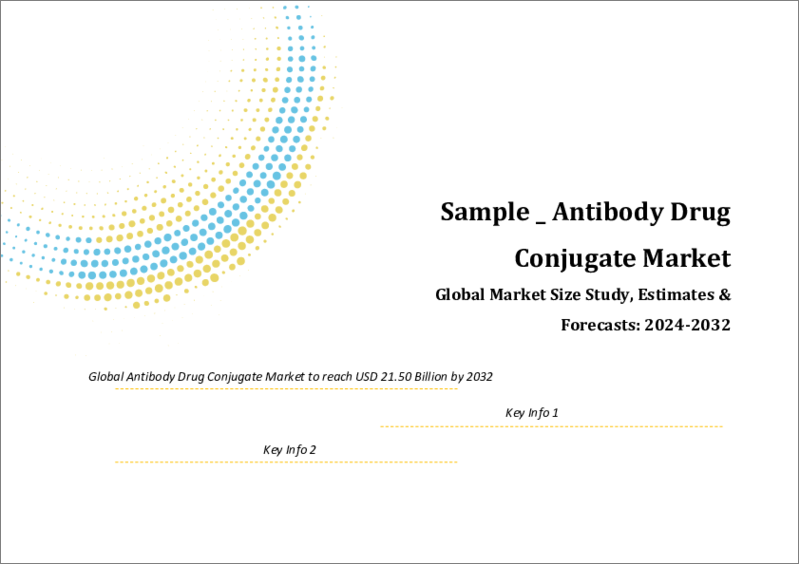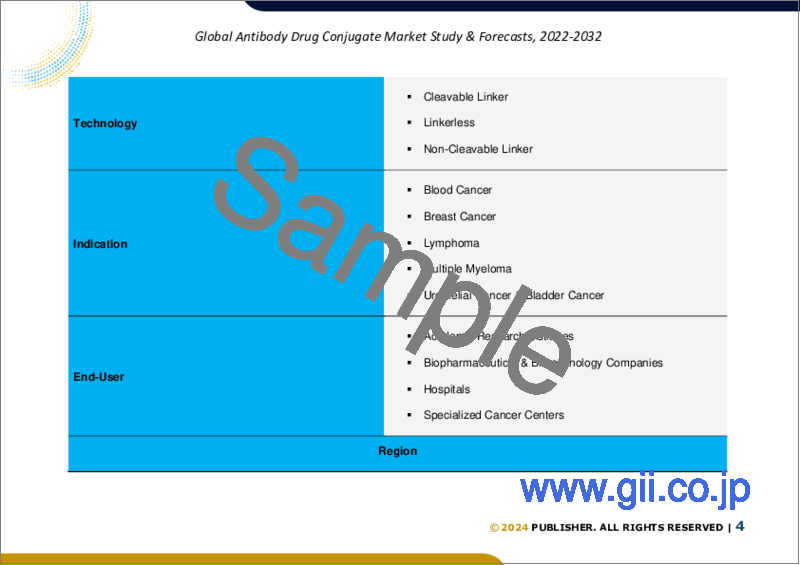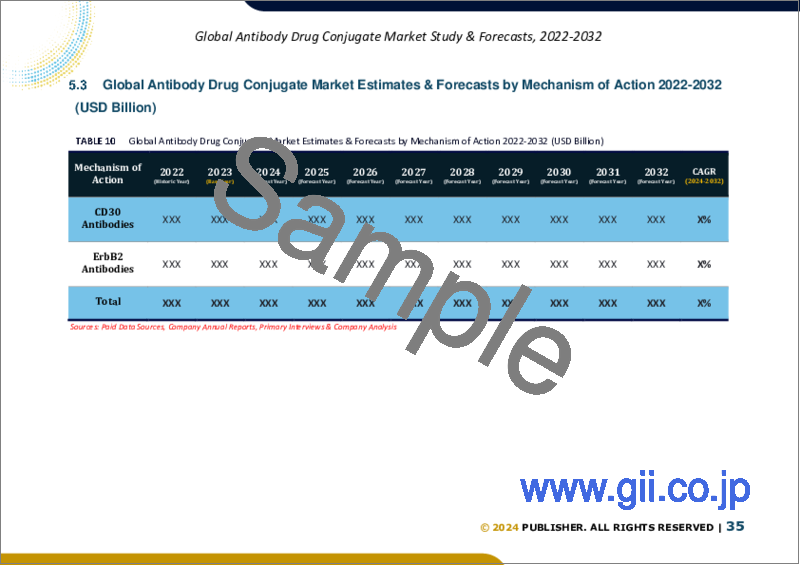|
|
市場調査レポート
商品コード
1517414
抗体薬物複合体の世界市場規模調査:作用機序別、薬剤別、技術別、適応症別、エンドユーザー別、地域別予測、2022年~2032年Global Antibody Drug Conjugate Market Size Study, by Mechanism of Action, by Drugs, by Technology, by Indication, by End User and Regional Forecasts 2022-2032 |
||||||
カスタマイズ可能
|
|||||||
| 抗体薬物複合体の世界市場規模調査:作用機序別、薬剤別、技術別、適応症別、エンドユーザー別、地域別予測、2022年~2032年 |
|
出版日: 2024年07月17日
発行: Bizwit Research & Consulting LLP
ページ情報: 英文 200 Pages
納期: 2~3営業日
|
- 全表示
- 概要
- 目次
世界の抗体薬物複合体市場は、2023年に約56億米ドルと評価され、予測期間2024-2030年には16.12%以上の健全な成長率で成長すると予測されています。
抗体薬物複合体(ADC)市場には、モノクローナル抗体と細胞傷害性薬剤を組み合わせた治療用分子の開発、製造、商品化が含まれます。これらのハイブリッド化合物は、健康な組織への毒性を最小限に抑えながら、がん細胞を選択的に標的として排除します。ADCは、従来の化学療法に比べて有効性が向上し、副作用が軽減されるため、腫瘍学で広く使用されています。世界のがん罹患率の継続的な上昇は、ADCのような革新的な治療法の必要性を煽っています。しかし、ADCの製造工程は複雑で、製品の均質性と安定性を確保するために複数の工程と厳格な品質管理措置が必要となるため、課題は多いです。さらに、自己免疫疾患や感染症など、がん以外の疾患へのADC技術の応用に関する調査も進められており、世界の最終用途部門によるADCの利用が促進されると期待されています。
ADC市場は、乳がんや胃がんの治療に有効であることから、ErbB2抗体(HER2)へのシフトが著しいです。これらのADCは、これらのがんで過剰発現しているHER2抗原を標的とすることで臨床的に大きな成功を収めています。Enhertuのような薬剤は、その標的治療により患者の転帰を改善することから、腫瘍学の分野で著名になった。ErbB2抗体が好まれていることは、市場が精密医療と標的治療アプローチに焦点を当てていることを裏付けています。
技術の進歩もADC市場を形成しており、リンカーレス技術への嗜好が高まっています。この技術は製造プロセスを簡素化し、ADCの安定性と均一性を向上させる。リンカーレスADCは細胞毒性薬剤を直接抗体に結合させるため、製造が合理化され、治療効果が高まる可能性があります。さらに、開裂性リンカーと非開裂性リンカーが引き続き重要な役割を果たしており、安定性と標的薬物放出の点でそれぞれに独自の利点があります。
適応症の面では、ADCは乳がんの治療薬として急速に普及しつつあります。HER2のような過剰発現したレセプターを標的とするADCの能力は、この一般的ながんタイプの治療に非常に有効です。さらに、ADCは血液がん、リンパ腫、多発性骨髄腫にも広く使用されており、腫瘍学におけるその多様性を示しています。これらの標的治療はがん治療に革命をもたらし、これまで選択肢が限られていた患者に新たな希望をもたらしています。
ADCのエンドユーザー層は多様であり、学術研究機関、バイオ製薬・バイオテクノロジー企業、病院、がん専門センターでの採用が顕著です。学術研究機関は、ADCのメカニズムの理解を進め、新たな治療用途を探索する上で不可欠です。バイオ医薬品・バイオテクノロジー企業はADC開発の最前線にあり、新規ターゲットの発見や薬剤結合技術の向上のために研究開発に多額の投資を行っています。病院や専門のがんセンターは、臨床試験を通じてADCの有効性を検証し、これらの革新的な治療法を臨床に取り入れる上で極めて重要な役割を果たしています。
抗体薬物複合体の世界市場調査において考慮した主要地域は、アジア太平洋地域、北米、欧州、ラテンアメリカ、その他世界のその他の地域です。北米は、収益面で抗体薬物複合体市場を独占している地域です。同地域の市場成長は、腫瘍学や標的療法の進歩を含む要因によるものです。欧州連合(EU)はADCに対する強固な規制枠組みを維持しており、戦略的共同研究や新規治療法の開発を促進しています。一方、アジア太平洋地域の市場は、研究開発費の増加とがんの蔓延がADCの必要性を高めており、予測期間中に最も速い速度で成長すると予測されています。さらに、ADC製造のための先端技術の採用は、最終用途分野でのADCの利用を促進すると予想されます。
目次
第1章 抗体薬物複合体の世界市場エグゼクティブサマリー
- 抗体薬物複合体の世界市場規模・予測(2022~2032年)
- 地域別概要
- セグメント別概要
- 主要動向
- 景気後退の影響
- アナリストの結論・提言
第2章 世界の抗体薬物複合体市場の定義と調査前提条件
- 調査目的
- 市場の定義
- 調査前提条件
- 包含と除外
- 制限事項
- 供給サイドの分析
- 入手可能性
- インフラ
- 規制環境
- 市場競争
- 経済性(消費者の視点)
- 需要サイド分析
- 規制の枠組み
- 技術の進歩
- 環境への配慮
- 消費者の意識と受容
- 調査手法
- 調査対象年
- 通貨換算レート
第3章 抗体薬物複合体の世界市場力学
- 市場促進要因
- がん罹患率の増加
- ADC技術の進歩
- がん領域以外への応用拡大
- 市場の課題
- 製造プロセスの複雑さ
- 高いコストと規制上のハードル
- 市場機会
- 環境に優しい医薬品の開発
- 製造技術の進歩
- 新興市場での拡大
第4章 抗体薬物複合体の世界市場産業分析
- ポーターのファイブフォースモデル
- 供給企業の交渉力
- 買い手の交渉力
- 新規参入業者の脅威
- 代替品の脅威
- 競争企業間の敵対関係
- ポーターのファイブフォースモデルへの未来的アプローチ
- ポーターのファイブフォースの影響分析
- PESTEL分析
- 政治
- 経済
- 社会
- 技術
- 環境
- 法律
- 主な投資機会
- 主要成功戦略
- 破壊的動向
- 業界専門家の視点
- アナリストの結論・提言
第5章 抗体薬物複合体の世界市場規模と予測:作用機序別、2022年~2032年
- セグメントダッシュボード
- 抗体薬物複合体の世界市場:収益動向分析、2022年・2032年
- CD30抗体
- ErbB2抗体
第6章 抗体薬物複合体の世界市場規模と予測:薬剤別、2022年~2032年
- セグメントダッシュボード
- 抗体薬物複合体の世界市場:収益動向分析、2022年・2032年
- アドセトリス
- ブレンレップ
- エンヘルトゥ
- カドサイラ
- パドチェフ
- トロデルヴィ
第7章 抗体薬物複合体の世界市場規模と予測:技術別、2022年~2032年
- セグメントダッシュボード
- 抗体薬物複合体の世界市場:収益動向分析、2022年・2032年
- 開裂可能リンカー
- リンカーレス
- 非開裂型リンカー
第8章 抗体薬物複合体の世界市場規模と予測:適応症別、2022年~2032年
- セグメントダッシュボード
- 抗体薬物複合体の世界市場:収益動向分析、2022年・2032年
- 血液がん
- 乳がん
- リンパ腫
- 多発性骨髄腫
- 尿路上皮がん・膀胱がん
第9章 抗体薬物複合体の世界市場規模と予測:エンドユーザー別、2022年~2032年
- セグメントダッシュボード
- 抗体薬物複合体の世界市場:収益動向分析、2022年・2032年
- 学術研究機関
- バイオ医薬品・バイオテクノロジー企業
- 病院
- がん専門センター
第10章 抗体薬物複合体の世界市場規模と予測:地域別、2022年~2032年
- 北米の抗体薬物複合体市場
- 米国の抗体薬物複合体市場
- カナダの抗体薬物複合体市場
- 欧州の抗体薬物複合体市場
- 英国の抗体薬物複合体市場
- ドイツの抗体薬物複合体市場
- フランス抗体薬物複合体市場
- スペインの抗体薬物複合体市場
- イタリアの抗体薬物複合体市場
- その他欧州の抗体薬物複合体市場
- アジア太平洋抗体薬物複合体市場
- 中国抗体薬物複合体市場
- インドの抗体薬物複合体市場
- 日本の抗体薬物複合体市場
- オーストラリアの抗体薬物複合体市場
- 韓国の抗体薬物複合体市場
- その他アジア太平洋地域の抗体薬物複合体市場
- ラテンアメリカの抗体薬物複合体市場
- ブラジル抗体薬物複合体市場
- メキシコの抗体薬物複合体市場
- その他ラテンアメリカの抗体薬物複合体市場
- 中東・アフリカの抗体薬物複合体市場
- サウジアラビアの抗体薬物複合体市場
- 南アフリカの抗体薬物複合体市場
- その他中東とアフリカの抗体薬物複合体市場
第11章 競合情報
- 主要企業のSWOT分析
- 主要市場戦略
- 企業プロファイル
- Roche Holding AG
- 主要情報
- 概要
- 財務(データの入手可能性によります)
- 製品概要
- 市場戦略
- GlaxoSmithKline PLC
- Daiichi Sankyo Company, Limited
- Seagen Inc.
- ADC Therapeutics SA
- ImmunoGen, Inc.
- Astellas Pharma Inc.
- Bayer AG
- Takeda Pharmaceutical Company Limited
- Sanofi S.A.
- Sorrento Therapeutics, Inc.
- BioNTech SE
- AbbVie Inc.
- AstraZeneca PLC
- Pfizer, Inc.
- Roche Holding AG
第12章 調査プロセス
- 調査プロセス
- データマイニング
- 分析
- 市場推定
- 検証
- 出版
- 調査属性
Global Antibody Drug Conjugate Market is valued at approximately USD 5.60 billion in 2023 and is anticipated to grow with a healthy growth rate of more than 16.12% over the forecast period 2024-2030. The Antibody Drug Conjugate (ADC) Market involves the development, manufacturing, and commercialization of therapeutic molecules that combine monoclonal antibodies with cytotoxic agents. These hybrid compounds selectively target and eliminate cancer cells while minimizing toxicity to healthy tissues. ADCs are widely used in oncology due to their enhanced efficacy and reduced side effects compared to traditional chemotherapy. The continuous rise in cancer prevalence globally fuels the need for innovative therapies such as ADCs. However, the complexity of the manufacturing process for ADCs is challenging, as they require multiple steps and stringent quality control measures to ensure product homogeneity and stability. Moreover, research is being conducted on applying ADC technologies to other diseases beyond oncology, including autoimmune disorders and infectious diseases, which is expected to encourage the utilization of ADCs by the end-use sectors worldwide.
The ADC market is experiencing a significant shift towards ErbB2 antibodies (HER2) due to their effectiveness in treating breast and gastric cancer. These ADCs have shown substantial clinical success in targeting the HER2 antigen, which is overexpressed in these cancers. Drugs like Enhertu have become prominent in the oncology field for their targeted therapies, providing improved patient outcomes. The preference for ErbB2 antibodies underscores the market's focus on precision medicine and targeted treatment approaches.
Technological advancements are also shaping the ADC market, with a rising preference for linkerless technology. This technology simplifies the manufacturing process and improves the stability and homogeneity of ADCs. Linkerless ADCs directly conjugate the cytotoxic drug to the antibody, offering streamlined production and potentially enhanced therapeutic efficacy. Additionally, cleavable and non-cleavable linkers continue to play crucial roles, with each offering unique benefits in terms of stability and targeted drug release.
In terms of indications, ADCs are rapidly gaining traction for treating breast cancer. Their ability to target overexpressed receptors, such as HER2, makes them highly effective in managing this prevalent cancer type. Furthermore, ADCs are extensively used for blood cancers, lymphomas, and multiple myeloma, demonstrating their versatility in oncology. These targeted therapies are revolutionizing cancer treatment, providing new hope for patients with previously limited options.
The end-user segment for ADCs is diverse, with significant adoption in academic research institutes, biopharmaceutical and biotechnology companies, hospitals, and specialized cancer centers. Academic research institutes are essential in advancing the understanding of ADC mechanisms and exploring new therapeutic applications. Biopharmaceutical and biotechnology companies are at the forefront of ADC development, investing heavily in R&D to discover novel targets and improve drug-linker technologies. Hospitals and specialized cancer centers play pivotal roles in validating ADC efficacy through clinical trials and integrating these innovative therapies into clinical practice.
The key regions considered for the global Antibody Drug Conjugate Market study include Asia Pacific, North America, Europe, Latin America, and Rest of the World. North America is a dominating region in the Antibody Drug Conjugate Market in terms of revenue. The market growth in the region is being attributed to factors including advancements in oncology and targeted therapies. The European Union (EU) maintains a robust regulatory framework for ADCs, fostering strategic collaborations and novel therapy developments. Whereas, the market in Asia Pacific is anticipated to grow at the fastest rate over the forecast period fueled by rising R&D expenditure and the prevalence of cancer are propelling the need for ADCs. Additionally, the adoption of advanced technologies for manufacturing ADCs is anticipated to drive their utilization across end-use sectors.
Major market player included in this report are:
- AbbVie Inc.
- AstraZeneca PLC
- Pfizer, Inc.
- Roche Holding AG
- GlaxoSmithKline PLC
- Daiichi Sankyo Company, Limited
- Seagen Inc.
- ADC Therapeutics SA
- ImmunoGen, Inc.
- Astellas Pharma Inc.
- Bayer AG
- Takeda Pharmaceutical Company Limited
- Sanofi S.A.
- Sorrento Therapeutics, Inc.
- BioNTech SE
The detailed segments and sub-segment of the market are explained below:
By Mechanism of Action
- CD30 Antibodies
- ErbB2 Antibodies
By Drugs
- Adcetris
- Blenrep
- Enhertu
- Kadcyla
- Padcev
- Trodelvy
By Technology
- Cleavable Linker
- Linkerless
- Non-Cleavable Linker
By Indication
- Blood Cancer
- Breast Cancer
- Lymphoma
- Multiple Myeloma
- Urothelial Cancer & Bladder Cancer
By End User
- Academic Research Institutes
- Biopharmaceutical & Biotechnology Companies
- Hospitals
- Specialized Cancer Centers
By Region:
- North America
- U.S.
- Canada
- Europe
- UK
- Germany
- France
- Spain
- Italy
- ROE
- Asia Pacific
- China
- India
- Japan
- Australia
- South Korea
- RoAPAC
- Latin America
- Brazil
- Mexico
- Middle East & Africa
- Saudi Arabia
- South Africa
- RoMEA
Years considered for the study are as follows:
- Historical year - 2022
- Base year - 2023
- Forecast period - 2024 to 2032
Key Takeaways:
- Market Estimates & Forecast for 10 years from 2022 to 2032.
- Annualized revenues and regional level analysis for each market segment.
- Detailed analysis of geographical landscape with Country level analysis of major regions.
- Competitive landscape with information on major players in the market.
- Analysis of key business strategies and recommendations on future market approach.
- Analysis of competitive structure of the market.
- Demand side and supply side analysis of the market.
Table of Contents
Chapter 1. Global Antibody Drug Conjugate Market Executive Summary
- 1.1. Global Antibody Drug Conjugate Market Size & Forecast (2022- 2032)
- 1.2. Regional Summary
- 1.3. Segmental Summary
- 1.3.1. By Mechanism of Action
- 1.3.2. By Drugs
- 1.3.3. By Technology
- 1.3.4. By Indication
- 1.3.5. By End User
- 1.4. Key Trends
- 1.5. Recession Impact
- 1.6. Analyst Recommendation & Conclusion
Chapter 2. Global Antibody Drug Conjugate Market Definition and Research Assumptions
- 2.1. Research Objective
- 2.2. Market Definition
- 2.3. Research Assumptions
- 2.3.1. Inclusion & Exclusion
- 2.3.2. Limitations
- 2.3.3. Supply Side Analysis
- 2.3.3.1. Availability
- 2.3.3.2. Infrastructure
- 2.3.3.3. Regulatory Environment
- 2.3.3.4. Market Competition
- 2.3.3.5. Economic Viability (Consumer's Perspective)
- 2.3.4. Demand Side Analysis
- 2.3.4.1. Regulatory frameworks
- 2.3.4.2. Technological Advancements
- 2.3.4.3. Environmental Considerations
- 2.3.4.4. Consumer Awareness & Acceptance
- 2.4. Estimation Methodology
- 2.5. Years Considered for the Study
- 2.6. Currency Conversion Rates
Chapter 3. Global Antibody Drug Conjugate Market Dynamics
- 3.1. Market Drivers
- 3.1.1. Increasing Cancer Prevalence
- 3.1.2. Advancements in ADC Technologies
- 3.1.3. Expanding Applications Beyond Oncology
- 3.2. Market Challenges
- 3.2.1. Complexity of Manufacturing Process
- 3.2.2. High Costs and Regulatory Hurdles
- 3.3. Market Opportunities
- 3.3.1. Development of Eco-friendly Drugs
- 3.3.2. Technological Advancements in Manufacturing
- 3.3.3. Expansion in Emerging Markets
Chapter 4. Global Antibody Drug Conjugate Market Industry Analysis
- 4.1. Porter's 5 Force Model
- 4.1.1. Bargaining Power of Suppliers
- 4.1.2. Bargaining Power of Buyers
- 4.1.3. Threat of New Entrants
- 4.1.4. Threat of Substitutes
- 4.1.5. Competitive Rivalry
- 4.1.6. Futuristic Approach to Porter's 5 Force Model
- 4.1.7. Porter's 5 Force Impact Analysis
- 4.2. PESTEL Analysis
- 4.2.1. Political
- 4.2.2. Economical
- 4.2.3. Social
- 4.2.4. Technological
- 4.2.5. Environmental
- 4.2.6. Legal
- 4.3. Top investment opportunity
- 4.4. Top winning strategies
- 4.5. Disruptive Trends
- 4.6. Industry Expert Perspective
- 4.7. Analyst Recommendation & Conclusion
Chapter 5. Global Antibody Drug Conjugate Market Size & Forecasts by Mechanism of Action 2022-2032
- 5.1. Segment Dashboard
- 5.2. Global Antibody Drug Conjugate Market: Mechanism of Action Revenue Trend Analysis, 2022 & 2032 (USD Billion)
- 5.2.1. CD30 Antibodies
- 5.2.2. ErbB2 Antibodies
Chapter 6. Global Antibody Drug Conjugate Market Size & Forecasts by Drugs 2022-2032
- 6.1. Segment Dashboard
- 6.2. Global Antibody Drug Conjugate Market: Drugs Revenue Trend Analysis, 2022 & 2032 (USD Billion)
- 6.2.1. Adcetris
- 6.2.2. Blenrep
- 6.2.3. Enhertu
- 6.2.4. Kadcyla
- 6.2.5. Padcev
- 6.2.6. Trodelvy
Chapter 7. Global Antibody Drug Conjugate Market Size & Forecasts by Technology 2022-2032
- 7.1. Segment Dashboard
- 7.2. Global Antibody Drug Conjugate Market: Technology Revenue Trend Analysis, 2022 & 2032 (USD Billion)
- 7.2.1. Cleavable Linker
- 7.2.2. Linkerless
- 7.2.3. Non-Cleavable Linker
Chapter 8. Global Antibody Drug Conjugate Market Size & Forecasts by Indication 2022-2032
- 8.1. Segment Dashboard
- 8.2. Global Antibody Drug Conjugate Market: Indication Revenue Trend Analysis, 2022 & 2032 (USD Billion)
- 8.2.1. Blood Cancer
- 8.2.2. Breast Cancer
- 8.2.3. Lymphoma
- 8.2.4. Multiple Myeloma
- 8.2.5. Urothelial Cancer & Bladder Cancer
Chapter 9. Global Antibody Drug Conjugate Market Size & Forecasts by End User 2022-2032
- 9.1. Segment Dashboard
- 9.2. Global Antibody Drug Conjugate Market: End User Revenue Trend Analysis, 2022 & 2032 (USD Billion)
- 9.2.1. Academic Research Institutes
- 9.2.2. Biopharmaceutical & Biotechnology Companies
- 9.2.3. Hospitals
- 9.2.4. Specialized Cancer Centers
Chapter 10. Global Antibody Drug Conjugate Market Size & Forecasts by Region 2022-2032
- 10.1. North America Antibody Drug Conjugate Market
- 10.1.1. U.S. Antibody Drug Conjugate Market
- 10.1.1.1. Mechanism of Action breakdown size & forecasts, 2022-2032
- 10.1.1.2. Drugs breakdown size & forecasts, 2022-2032
- 10.1.1.3. Technology breakdown size & forecasts, 2022-2032
- 10.1.1.4. Indication breakdown size & forecasts, 2022-2032
- 10.1.1.5. End User breakdown size & forecasts, 2022-2032
- 10.1.2. Canada Antibody Drug Conjugate Market
- 10.1.2.1. Mechanism of Action breakdown size & forecasts, 2022-2032
- 10.1.2.2. Drugs breakdown size & forecasts, 2022-2032
- 10.1.2.3. Technology breakdown size & forecasts, 2022-2032
- 10.1.2.4. Indication breakdown size & forecasts, 2022-2032
- 10.1.2.5. End User breakdown size & forecasts, 2022-2032
- 10.1.1. U.S. Antibody Drug Conjugate Market
- 10.2. Europe Antibody Drug Conjugate Market
- 10.2.1. U.K. Antibody Drug Conjugate Market
- 10.2.1.1. Mechanism of Action breakdown size & forecasts, 2022-2032
- 10.2.1.2. Drugs breakdown size & forecasts, 2022-2032
- 10.2.1.3. Technology breakdown size & forecasts, 2022-2032
- 10.2.1.4. Indication breakdown size & forecasts, 2022-2032
- 10.2.1.5. End User breakdown size & forecasts, 2022-2032
- 10.2.2. Germany Antibody Drug Conjugate Market
- 10.2.3. France Antibody Drug Conjugate Market
- 10.2.4. Spain Antibody Drug Conjugate Market
- 10.2.5. Italy Antibody Drug Conjugate Market
- 10.2.6. Rest of Europe Antibody Drug Conjugate Market
- 10.2.1. U.K. Antibody Drug Conjugate Market
- 10.3. Asia-Pacific Antibody Drug Conjugate Market
- 10.3.1. China Antibody Drug Conjugate Market
- 10.3.2. India Antibody Drug Conjugate Market
- 10.3.3. Japan Antibody Drug Conjugate Market
- 10.3.4. Australia Antibody Drug Conjugate Market
- 10.3.5. South Korea Antibody Drug Conjugate Market
- 10.3.6. Rest of Asia Pacific Antibody Drug Conjugate Market
- 10.4. Latin America Antibody Drug Conjugate Market
- 10.4.1. Brazil Antibody Drug Conjugate Market
- 10.4.2. Mexico Antibody Drug Conjugate Market
- 10.4.3. Rest of Latin America Antibody Drug Conjugate Market
- 10.5. Middle East & Africa Antibody Drug Conjugate Market
- 10.5.1. Saudi Arabia Antibody Drug Conjugate Market
- 10.5.2. South Africa Antibody Drug Conjugate Market
- 10.5.3. Rest of Middle East & Africa Antibody Drug Conjugate Market
Chapter 11. Competitive Intelligence
- 11.1. Key Company SWOT Analysis
- 11.2. Top Market Strategies
- 11.3. Company Profiles
- 11.3.1. Roche Holding AG
- 11.3.1.1. Key Information
- 11.3.1.2. Overview
- 11.3.1.3. Financial (Subject to Data Availability)
- 11.3.1.4. Product Summary
- 11.3.1.5. Market Strategies
- 11.3.2. GlaxoSmithKline PLC
- 11.3.3. Daiichi Sankyo Company, Limited
- 11.3.4. Seagen Inc.
- 11.3.5. ADC Therapeutics SA
- 11.3.6. ImmunoGen, Inc.
- 11.3.7. Astellas Pharma Inc.
- 11.3.8. Bayer AG
- 11.3.9. Takeda Pharmaceutical Company Limited
- 11.3.10. Sanofi S.A.
- 11.3.11. Sorrento Therapeutics, Inc.
- 11.3.12. BioNTech SE
- 11.3.13. AbbVie Inc.
- 11.3.14. AstraZeneca PLC
- 11.3.15. Pfizer, Inc.
- 11.3.1. Roche Holding AG
Chapter 12. Research Process
- 12.1. Research Process
- 12.1.1. Data Mining
- 12.1.2. Analysis
- 12.1.3. Market Estimation
- 12.1.4. Validation
- 12.1.5. Publishing
- 12.2. Research Attributes






